
- MuleSoft - Home
- MuleSoft - Introduction to Mule ESB
- MuleSoft - The Mule Project
- MuleSoft - Mule in Our Machine
- MuleSoft - Anypoint Studio
- MuleSoft - Discovering Anypoint Studio
- Creating First Mule Application
- MuleSoft - DataWeave Language
- Message Processor & Script Components
- Core Components & Their Configuration
- MuleSoft - Endpoints
- Flow Control and Transformers
- Web Services Using Anypoint Studio
- MuleSoft - Mule Error Handling
- MuleSoft - Mule exception Handling
- MuleSoft - Testing with MUnit
- MuleSoft Useful Resources
- MuleSoft - Quick Guide
- MuleSoft - Useful Resources
- MuleSoft - Discussion
MuleSoft - Discovering Anypoint Studio
Anypoint Studio editors help us design our applications, APIs, properties and configuration files. Along with designing, it also helps us to edit them. We have the Mule configuration file editor for this purpose. To open this editor, double-click on the application XML file in /src/main/mule.
To work with our application, we have the following three tabs under Mule Configuration file editor.
The Message Flow tab
This tab gives a visual representation of work flow. It basically contains a canvas that helps us check our flows visually. If you want to add Event Processors from the Mule Palette into the canvas, then just drag and drop and it will reflect in the canvas.
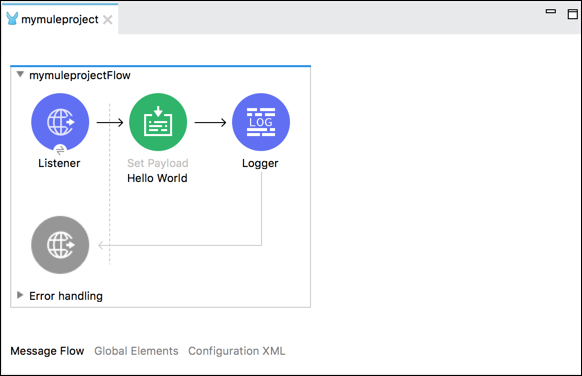
By clicking on an Event Processor, you can get the Mule Properties View with the attributes for the selected processor. We can also edit them.
The Global Elements tab
This tab contains the global Mule configuration elements for the modules. Under this tab we can create, edit or delete configuration files.
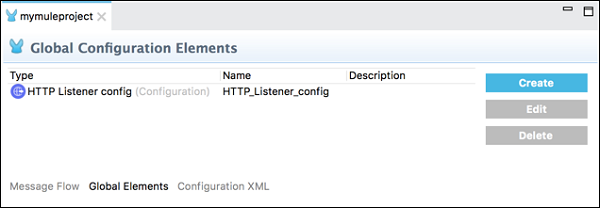
The Configuration XML tab
As the name implies, it contains the XML that defines your Mule application. All the changes you do here will reflect in the canvas as well as the properties view of event processor under the Message Flow tab.

Views
For the active editor, Anypoint studio gives us the graphical representation of our project metadata, properties with the help of views. A user can move, close as well as add views in the Mule project. Following are some default views in Anypoint studio −
Package Explorer
The main task of Package Explorer view is to display the project folders and files consisted in a Mule project. We can expand or contract the Mule project folder by clicking on the arrow next to it. A folder or file can be opened by double clicking it. Have a look at its screenshot −
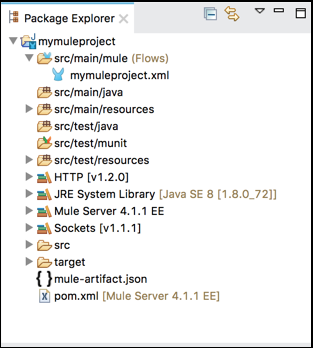
Mule Palette
Mule Palette view shows the event processors like scopes, filters, and flow control routers along with modules and their related operations. The main tasks of Mule Palette view are as follows −
- This view helps us to manage the modules and connectors in our project.
- We can also add new elements from Exchange.
Have a look at its screenshot −
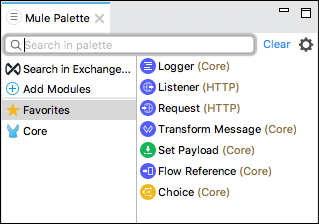
Mule Properties
As the name implies, it allows us to edit the properties of the module currently selected in our canvas. Mule Properties view includes the following −
DataSense Explorer that supplies real-time information about the data structure of our payload.
Inbound and outbound properties, if available or variables.
Below is the screenshot −
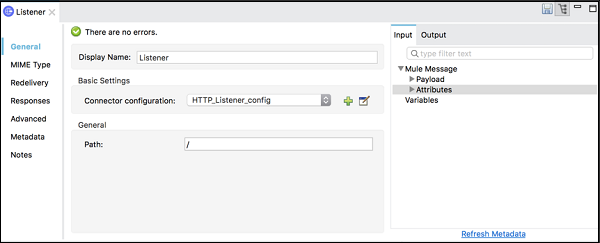
Console
Whenever we create or run the Mule application, embedded Mule server displays a list of events and problems, if any, reported by Studio. Console view contains the console of that embedded Mule server. Have a look at its screenshot −

Problems View
We can encounter many issues while working on our Mule Project. All those issues are displayed in the Problems view. Below is the screenshot

Perspectives
In Anypoint Studio, it is a collection of views and editors in a specified arrangement. There are two kinds of perspectives in Anypoint Studio −
Mule Design Perspective − It is the default perspective we get in Studio.
Mule Debug Perspective − Another perspective supplied by Anypoint Studio is Mule Debug Perspective.
On the other hand, we can also create our own perspective and can add or remove any of the default views.